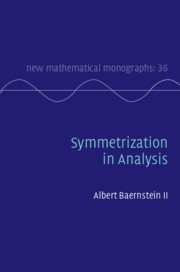Book contents
- Frontmatter
- Contents
- Notation
- Foreword
- Preface
- Introduction
- 1 Rearrangements
- 2 Main Inequalities on Rn3
- 3 Dirichlet Integral Inequalities
- 4 Geometric Isoperimetric and Sharp Sobolev Inequalities
- 5 Isoperimetric Inequalities for Physical Quantities
- 6 Steiner Symmetrization
- 7 Symmetrization on Spheres, and Hyperbolic and Gauss Spaces
- 8 Convolution and Beyond
- 9 The ⋆-Function
- 10 Comparison Principles for Semilinear Poisson PDEs
- 11 The ⋆-Function in Complex Analysis
- References
- Index
4 - Geometric Isoperimetric and Sharp Sobolev Inequalities
Published online by Cambridge University Press: 22 February 2019
- Frontmatter
- Contents
- Notation
- Foreword
- Preface
- Introduction
- 1 Rearrangements
- 2 Main Inequalities on Rn3
- 3 Dirichlet Integral Inequalities
- 4 Geometric Isoperimetric and Sharp Sobolev Inequalities
- 5 Isoperimetric Inequalities for Physical Quantities
- 6 Steiner Symmetrization
- 7 Symmetrization on Spheres, and Hyperbolic and Gauss Spaces
- 8 Convolution and Beyond
- 9 The ⋆-Function
- 10 Comparison Principles for Semilinear Poisson PDEs
- 11 The ⋆-Function in Complex Analysis
- References
- Index
Summary
This chapter is devoted to the isoperimetric inequality and sharp Sobolev inequalities.
Itbegins with a review of tools from geometric measure theory(Hausdorff measures,area formula, and Gauss--Green theorem) used in this and later chapters. Three isoperimetric inequalities are presented: for perimeter,for Hausdorff measures, and for Minkowski content. Additional facts from geometric measure theory (the coarea formula, and polar coordinates) are included to showthat the coarea formula and the isoperimetric inequality for perimeter together imply decrease of the Dirichlet integral under symmetrization.The sharp Sobolev inequality for p = 1, and its equivalence to the isoperimeric inequality, are due to Federer and Fleming (1960). As discussed in the text, the sharp Sobolev inequality for 1 < p < n is due independently to Rodemich, Aubin and Talenti. The proof presented in this book is a hybrid using both the “classical” method of symmetrization and the recent mass transportation approach of Cordero-Erausquin et al.
Keywords
Information
- Type
- Chapter
- Information
- Symmetrization in Analysis , pp. 119 - 152Publisher: Cambridge University PressPrint publication year: 2019
